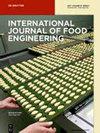Chemical stability of β-carotene composite or bilayer emulsions coated with pea protein isolate and γ-polyglutamic acid compared to monolayer emulsion
IF 1.6
4区 农林科学
引用次数: 0
Abstract
The integration of β-carotene into functional foods is limited due to its limited hydrophilicity and chemical stability. To address this issue, emulsion was encouraged to be utilized. Monolayer, composite, and bilayer emulsions were prepared using pea protein isolate (PPI) alone or in combination with poly-γ-glutamic acid (γ-PGA). Our findings indicate that the bilayer emulsion utilizing γ-PGA as an external emulsifier exhibited the smallest droplet size (737.61 nm) and highest zeta potential (−35.23 mV). Under various environmental stresses, the chemical stability of the composite emulsion surpassed that of the monolayer emulsion but was inferior to that of the bilayer emulsion. Moreover, following simulated gastrointestinal digestion, the β-carotene bioaccessibility in the composite emulsion (12.76 %) exceeded that in the monolayer emulsion (6.57 %) but was less than that in the bilayer emulsion (20.01 %). Therefore, the emulsion preparation method or the sequence of γ-PGA addition significantly affects emulsion stability. Among the studied emulsions, the bilayer emulsion demonstrated the most stable structure, enhancing the stability of β-carotene within the oil droplets.与单层乳液相比,涂有豌豆蛋白分离物和γ-聚谷氨酸的β-胡萝卜素复合乳液或双层乳液的化学稳定性
由于亲水性和化学稳定性有限,β-胡萝卜素在功能食品中的应用受到限制。为解决这一问题,我们鼓励使用乳液。我们使用豌豆蛋白分离物(PPI)单独或与聚-γ-谷氨酸(γ-PGA)结合制备了单层、复合和双层乳液。我们的研究结果表明,使用 γ-PGA 作为外乳化剂的双层乳液显示出最小的液滴尺寸(737.61 nm)和最高的 zeta 电位(-35.23 mV)。在各种环境压力下,复合乳液的化学稳定性超过了单层乳液,但低于双层乳液。此外,在模拟胃肠道消化过程中,复合乳液中的β-胡萝卜素生物利用率(12.76%)超过了单层乳液中的β-胡萝卜素生物利用率(6.57%),但低于双层乳液中的β-胡萝卜素生物利用率(20.01%)。因此,乳液制备方法或添加 γ-PGA 的顺序对乳液稳定性有很大影响。在所研究的乳液中,双层乳液的结构最为稳定,提高了β-胡萝卜素在油滴中的稳定性。
本文章由计算机程序翻译,如有差异,请以英文原文为准。
求助全文
约1分钟内获得全文
求助全文
来源期刊
CiteScore
3.20
自引率
0.00%
发文量
52
审稿时长
3.8 months
期刊介绍:
International Journal of Food Engineering is devoted to engineering disciplines related to processing foods. The areas of interest include heat, mass transfer and fluid flow in food processing; food microstructure development and characterization; application of artificial intelligence in food engineering research and in industry; food biotechnology; and mathematical modeling and software development for food processing purposes. Authors and editors come from top engineering programs around the world: the U.S., Canada, the U.K., and Western Europe, but also South America, Asia, Africa, and the Middle East.

 求助内容:
求助内容: 应助结果提醒方式:
应助结果提醒方式:


